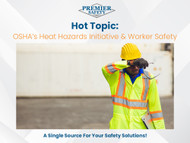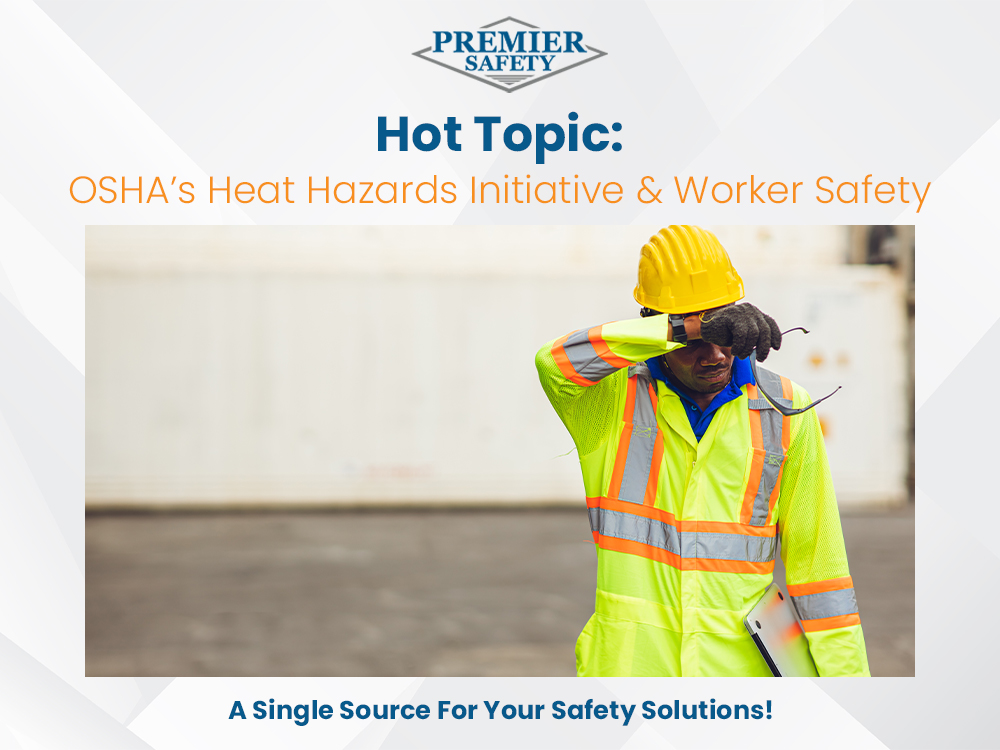Hot Topic: OSHA's Heat Hazards Initiative & Worker Safety
Posted by Michael Womack - Premier Safety on Jun 12th 2023
Hot Topic: OSHA's Heat Hazards Initiative & Worker Safety
It's important to prioritize worker safety in all industries. However, we often forget about the risks posed by heat to employees. The Occupational Safety and Health Administration (OSHA) has created the National Emphasis Program (NEP) to address outdoor and indoor heat hazards. This program provides guidance on how to protect workers from these risks.
The NEP is designed to proactively address heat-related risks. It also sets out guidelines to ensure the safety and wellbeing of workers in hot environments. We will look at the main aspects of the NEP in this blog post.
Employers can prepare for OSHA inspections and create a safe working environment. Let's talk about how to do this.
The NEP and the Path to a Federal Heat Stress Standard:
As part of its ongoing efforts to mitigate heat hazards, OSHA has introduced the NEP on Outdoor and Indoor Heat Hazards. This program signifies an important step towards the development of a federal heat stress standard.
OSHA has announced a National Enforcement Initiative. This is to increase public awareness about the risks associated with working in high temperatures. Additionally, OSHA is establishing comprehensive regulations to protect workers.
What to Expect During OSHA Inspections
Inspections under the NEP: Safety officers will inspect workplaces on days with heat warnings or advisories from the National Weather Service. If the heat index reaches 80°F or higher, inspectors and specialists will offer support and guidance to ensure worker safety. If violations are identified, Area Directors can issue citations for hazards under the General Duty Clause. Employers may also receive Hazard Alert Letters (HALs) to address specific concerns.
Preparation: Ensuring Worker Safety in High Temperature Environments
To comply with the NEP and promote a safe working environment, employers should take several crucial steps:
1. Safety Policies: Review and update safety policies to specifically address heat-related hazards. Ensure that they are readily accessible to all employees and emphasize the importance of heat illness prevention.
2. Acclimatization Periods: Implement acclimatization periods for new employees, allowing them to gradually adjust to working in hot conditions. This process helps reduce the risk of heat-related illnesses.
3. Monitoring and Awareness: Develop a means to monitor the heat index and measure workers' exposure to heat. Utilize technology or manual monitoring methods to keep track of environmental conditions and take necessary precautions accordingly.
4. Training: Educate employees about the signs and symptoms of heat-related illnesses, such as heat exhaustion and heat stroke. Train them on preventive measures, emergency response protocols, and the importance of staying hydrated and seeking shade during high-temperature periods.
Key Elements for Effective Heat Hazard Management:
Employers should focus on the following key elements to effectively manage heat hazards in the workplace:
OSHA Inspections and Compliance:
To ensure compliance with the NEP, OSHA conducts inspections randomly on high heat days. OSHA officials will inspect injury and illness logs, incident reports, and records of emergency room visits or ambulance transport. These records are related to heat-related illnesses.
They will also interview workers to assess their knowledge of heat illness symptoms and dehydration. Furthermore, OSHA inspectors will evaluate if the employer has a comprehensive heat illness and injury prevention program in place.
Conclusion
OSHA's National Emphasis Program on Outdoor and Indoor Heat Hazards emphasizes the need to assess heat-related risks in the workplace. This highlights the importance of taking action to reduce these risks.
Employers must prioritize the safety and well-being of their workers. This can be done by developing effective policies, providing training, monitoring conditions and establishing protocols. These protocols should focus on heat hazard prevention and emergency response.
Companies can reduce the risk of heat-related illnesses by taking proactive measures. This can improve worker productivity and create a positive work environment. It is vital for employers to keep up to date with OSHA regulations and guidelines on heat hazards. This is to ensure compliance and keep their employees safe from the serious effects of heat stress.
Prioritize worker safety in high-temperature environments. This will not only safeguard the physical well-being of employees, but also promote a culture of care, trust, and productivity. Remember, this is beneficial for the organization.


